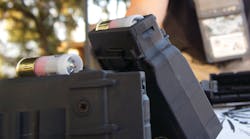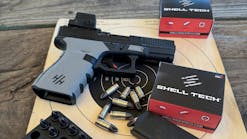A tale of conversion: Adaptive Tactic's Sindwinder Venom Kit for Shotguns
Not long ago I tested Adaptive Tactical’s Sidewinder Venom Conversion Kit, products that will switch a tubular magazine shotgun to a box magazine gun on the Mossberg 590. Adaptive Tactical has been in the business for 40 years. They are known for producing products like recoil dampening stocks and conversion kits. The Sidewinder Venom Conversion Kit has been around long enough to establish a reputation for reliability. The company makes three different conversion kits: one with a 10-round rotary magazine, one with a 5-round box magazine, and a third with the 10-round rotary magazine and an M-4 style stock.
I tested the conversion with the 10-round rotary and 5-round box magazines. This is an end user installed kit designed for installation by a competent user. The magazines are made of polymer and metal—much thicker and heavier than I anticipated. The magazine conversion adds a magazine well just in front of the receiver, replacing the magazine tube and slide with their proprietary set up.
The kit is designed to convert several different Mossberg 12-gauge models. For this test, I picked a Mossberg 590A1 with the Tactical Tri-Rail. This is similar to the Mossberg 590 A1 US Service Model, which is my favorite. The US Service Model is beefed up, but it still maintains the iconic Mossberg tactical shotgun profile.
This particular Mossberg 590 has a 6-position M4 style stock, 20-inch barrel, metal fixtures and ghost ring sights. I don’t like the looks of this kind of stock on a shotgun, but it adds to vest/carrier quick changes and is especially handy for officers with multiple assignments.
The Adaptive Tactical conversion kits are a complete package, and even include the cutting tool for fitting the magazine tube onto the receiver.
Besides greater fire continuity, why would the law enforcement user want to go with a detachable magazine shotgun? For many agencies, it’s about options. By this time, readers here have already heard the argument in favor of using slugs. (Editor’s note: see the September issue of LET for more on slugs.) A slug shotgun can deliver carbine-like performance with a smoothbore. However, there are many types of slugs, and it would be reasonable to have a selection of tools.
For me, there would be three types of slugs from which I would draw: A fragmentary slug like Rio’s Royal Expansive Fragmentary Slug Cartridge for general applications; a Brenneke Slug Cartridge for intermediate targets and a steel core slug like the Rio Royal Armored Slug Cartridge for special applications. Rio’s Royal Armored Slug is a composite projectile with a steel core. The projectile is 1 1/8 ounces post impact, the lead fragments delivering a barrier-penetrating payload. Some agencies prefer buckshot for entry use, which is also an excellent choice.
Adaptive Tactical Conversion Kits are relatively inexpensive, given the quality of the engineering. Still, I recommend spending the money and having them do the installation. It was't particularly hard for me, it’s just that they have a great custom camouflage matching service. You know, new digs after accessorizing.
I talked with Gary Cauble of Adaptive Tactical before installing the magazine. Gary explained that the supplied cutting tool is for the receiver area where the magazine tube is inserted. I ended up talking to Gary again, after I realized that I ordered a 9-shot Mossberg 590 and the Sidewinder Venom kit was designed for a 6-shot gun. This was easily remedied and my experience will benefit everyone. The Sidewinder Venom Kit fits; it just needs a barrel appropriate for a 6-round Mossberg. Since they can be easily purchased in drop-in configuration, this was a quick fix. The 9-round barrel is the same as the 6-round, with the barrel loop further toward the muzzle.
Installing the Sidewinder Kit begins with an unloaded shotgun. Whenever I check any firearm, I look at the magazine, chamber and action, and then verbally declare the gun is unloaded, usually with “Chamber is clear.” Old military habits seldom die.
The gun is field stripped, followed by gently unscrewing the magazine tube. The Sidewinder Kit tube replaces the Mossberg tube. Mossberg products are known for being rather beefy, which is why the Mossberg 590 series is the king of working shotguns. The Adaptive Tactical magazine tube, which actually holds a piston that cycles when one actuates the slide, is just as robust.
The Mossberg 590 series of shotgun barrels is not interchangeable with the Mossberg 500 series of shotgun barrels. The Mossberg 500 uses a screw at the end of the takedown knob, which is connected to the barrel. The Mossberg 590 uses a barrel loop, similar to many other shotguns. The barrel is secured to the end of the magazine using a magazine cap.
Disassembly of the Mossberg 590 includes drifting the trigger group 10 and removing the trigger group. For users who like to examine their parts as they are removed, remember that pulling the trigger at this point will seriously damage the gun.
I have always liked the way that Mossberg designed their shell stops, which are removable, adding to the end user serviceability of the firearm. In fact, end user serviceability is their second most important selling point to law enforcement. What’s the primary point? Bulletproof reliability.
Once disassembled, one threads the Venom Magazine Tube Assembly into the receiver. If the center line of the magazine aligns vertically when the tube is fully seated, no fitting is required. If it doesn't, one uses the cutting tool to modify the receiver.
I guess it’s time for me to talk a little bit about modifying a firearm. If what is being said in this article is a little too technical or the end-user isn’t 100 percent certain what they are doing, it is wise to stop at “The gun is field stripped…” Removing receiver material using a cutting tool is not undoable.
If anyone is wondering, I found that one can generally restore the shotgun to its original state, in case the gun is repurposed to less lethal or breaching rounds. Having said that, what’s wrong repurposing a box-fed gun to less lethal? There’s nothing wrong with options.
Consider these options: Lightfield’s StarLite less lethal round was designed for distances between 1 to 10 yards. Their MidRange Rubber Slug can do 20 to 40 yards. I have tested both in my Remington 870 and they do exactly what they say they will do. A box magazine gun would be an advantage here.
Once the new magazine tube is installed, the original slide is replaced with Adaptive Tactical’s slide, which dropped right in. Instead of using the magazine tube, a follower assembly, which is really a plunger that is connected to the slide by a keeper key, manually strips rounds from the magazine.
When I tested the assembled gun, I found that Adaptive Tactical uses moving parts made of polymer in the slide to contact the metal parts, which reduces action noise and seems to add to smooth operation. Using the 5-round box magazine, the cycling time was a bit faster. This might be explained by the fact that the piston assembly literally shoveled a fresh round into the carrier.
Shotgun shells fed from a magazine introduce new engineering concepts that do not generally present themselves in metallic cartridges. First, let’s get this out of the way—this setup is designed for 2 3/4-inch shells only. For law enforcement, this restriction isn’t very limiting. However, if this were for hunting, it wouldn't work. There is an optional Kelly grip, which is a protruding handle that screws into one of the three holes in the slide handle. It was designed to add comfort and speed to cycling the gun, especially when using the 10-round rotary magazine. This magazine weighs 21.5 ounces empty, which is enough to be noticeable to the shooter. The Kelly grip is a good idea.
Second, some questions are immediately raised when one looks into shotgun design; 12-gauge bores can vary up to 2 mm. Squeeze any commercial load and the sides will “give” a little. Getting cartridges to feed reliably is a challenge.
How did Adaptive Tactical do it? Using spring loaded feed lips and a very specialized follower, that’s how. Actually, the 10-round rotary magazine uses a roller for a follower that accommodates for any shifting or variances. On the range, the Adaptive Tactical Sidewinder Venom Kit fed smoothly, but the 5-round magazine felt better than the 10-round rotary magazine. Under the force of recoil, the weight of the full magazine torqued it a bit. The Kelly grip compensated for the torque, which means Adaptive Tactical tests their stuff before it’s fielded. Still, any shooter can outrun many autos, and still have rounds to spare, with this setup.
We didn't notice any difference in reliability, which is no surprise. It takes a pretty good shove to seat the magazines, but they stay put. I’m not sure if it actually amped up the cycling time, but the loading system felt smoother.
We didn't experience any feed lip failures like shells falling out of the magazine when dropped. I’m pretty sure these magazines can survive heavy abuse. They are rigid enough for a full grown adult to stand on one without deformation.
I have already seen specialty pouches for both sizes of magazines available from third party vendors. Adaptive Tactical also has one on their site. This would be the ideal setup for the officer who dons additional armor and responds to major incidents in progress.
Adaptive Tactical’s Sidewinder Venom Conversion Kit is a viable option for the agency that uses a high performance shotgun, and adds capacity and flexibility to the package. It proved to be a reliable and solid method for cranking out a lot of rounds in a very short time.

Officer Lindsey Bertomen (ret.), Contributing Editor
Lindsey Bertomen is a retired police officer and retired military small arms trainer. He teaches criminal justice at Hartnell College in Salinas, California, where serves as a POST administrator and firearms instructor. He also teaches civilian firearms classes, enjoys fly fishing, martial arts, and mountain biking. His articles have appeared in print and online for over two decades.



